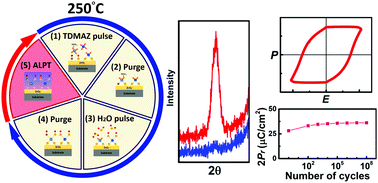Low-temperature crystallization and paraelectric–ferroelectric phase transformation in nanoscale ZrO2 thin films induced by atomic layer plasma treatment
Abstract
In recent years, Hf/ZrO2-based thin films have emerged as promising candidates for ferroelectric materials in various applications. However, achieving ferroelectricity with a low-temperature process has remained a challenging task. In this study, the atomic layer plasma treatment (ALPT) technique, where an in situ Ar plasma treatment is introduced into each cycle of atomic layer deposition (ALD), was used to achieve crystallization and ferroelectricity in as-deposited ZrO2 thin films at a low temperature of 250 °C. The ALPT treatment effectively contributes to a high-temperature annealing effect, leading to enhanced crystallization and densification of the films. In addition, the ALPT process also induces a transformation from paraelectric to ferroelectric orthorhombic phase in the as-deposited ZrO2 thin films, exhibiting a high ferroelectric switching polarization of 30 μC cm−2 along with great endurance characteristics up to 108 switching cycles. This study demonstrates that ALPT is an effective approach to enhance and tailor the crystallization and dielectric characteristics of nanoscale thin films at a low temperature, which is highly advantageous and demanded in a variety of applications and research fields encompassing nanoelectronic, energy storage, and biomedical devices.

- This article is part of the themed collection: Journal of Materials Chemistry C HOT Papers


 Please wait while we load your content...
Please wait while we load your content...